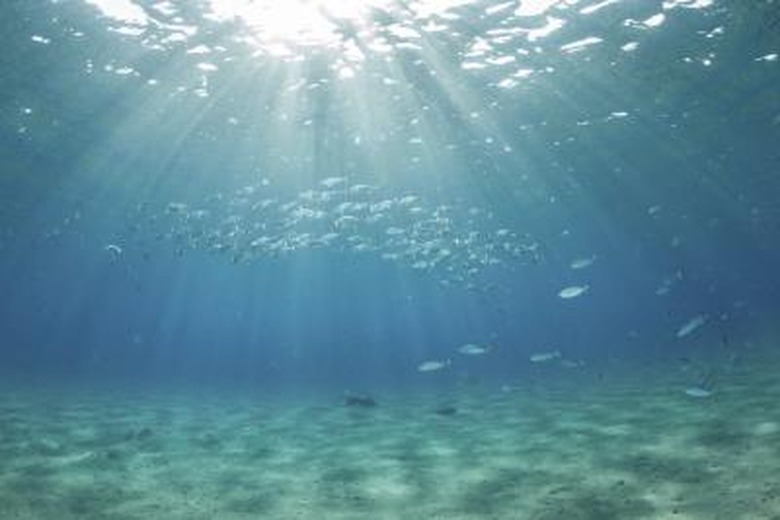What Kinds Of Plants Live In The Aquatic Biome?
There are five biomes on Earth: aquatic, desert, forest, grasslands and tundra. With water covering nearly 75 percent of the Earth's surface, the aquatic biome is the largest. There are two categories of aquatic biome: freshwater and marine.
Freshwater Aquatic Biomes
Freshwater Aquatic Biomes
Freshwater regions total less than 1 percent of all the water on Earth, but they provide most of our drinking water and support almost half the number of fish on Earth. Freshwater has a low concentration of salt, generally less than 1 percent. There are three freshwater zones: ponds and lakes, streams and rivers, and wetlands. Each provides habitat for particular species of plants, both rooted and floating. Rooted plants are often live fully submerged and get less sunlight, so they are less productive.
Ponds and lakes are standing bodies of fresh water with distinct zones that support different types of plants. The water near the shoreline is shallow and warm and is home to algae and rooted and floating aquatic plants. Rooted plants may include cattail and several types of aquatic grasses. These plants help reduce erosion and provide habitat for wildlife and food for waterfowl. Floating plants are either rooted in sediment, such as waterlily, or are free-floating, such as water hyacinth and water lettuce. Floating plants often contribute debris, which adds to the sediment and makes the water shallower.
Deeper waters provide a home to submerged plants that root in the sediment below. No part of these plants rise above the water. Examples of submerged plants are tapegrass and hydrilla. These submerged plants not only provide a habitat for aquatic life, but they also help to stabilize shorelines and improve water clarity.
The center, where the lake is usually deepest, generally provides favorable conditions only for algae or phytoplankton. Algae may grow in clusters and form mats, or attach itself to plants or even the bottom of the lake.
Streams and rivers start at a headwater and flow in one direction until they end at the mouth, usually located at the intersection of another larger waterway or the ocean, and their characteristics change along the way. The water is cool and clear at the source and tends to widen at the middle part. It may widen and narrow several times before coming to an end at the mouth. The wider stretches are where most of the plant life, including green plants and algae, are found. The water at this point has more nutrients, tends to move more slowly, and is shallower and warmer. Near the mouth, accumulated sediment reduces the amount of oxygen and prevents light from reaching the bottom, inhibiting the growth of plants there.
Wetlands, areas of standing water such as marshes, swamps and bogs, are generally freshwater, but some, such as salt marshes, have high concentrations of salt. Marshes are usually covered by water all year, and plants are emergent (leaves and stems come above water level), including pond lilies, cattails, sedges, tamarack and black spruce. Swamps, forested wetlands, are home to trees and shrubs that tolerate flooded conditions, such as bald cypress and Virginia willow, as well as some species of vines and floating plants. A bog gets its water only from rain and snow. Since it offers few nutrients, it can only support plants such as sphagnum moss and labrador tea.
Marine Aquatic Biomes
Marine Aquatic Biomes
The marine biome is the largest of all the ecosystems and includes not only shoreline and open ocean areas but also coral reefs and estuaries. Marine algae supply most of the world's oxygen.
Like in lakes and ponds, plant life in oceans varies by location. Where ocean meets land, waves move in and out, causing the shore community to constantly change. The waves cause shifting of mud and sand, making it difficult, if not impossible, for algae and plants to establish themselves. The areas that the sea only reaches at high tides generally support algae; the areas that are exposed only during low tides create favorable conditions for seaweed.
The open ocean waters are colder; surface seaweeds or plankton are common here. The ocean depths are colder still and receive less sunlight; phytoplankton grow on the surface, but few submerged plants grow here.
Coral reefs exist in warm, shallow waters, as barriers along continents, beside islands or existing on their own as an atoll. Estuaries form where freshwater streams or rivers merge with the ocean. The combining of salt concentrations support microflora such as algae as well as macroflora like seaweeds, marsh grasses and, in the tropics, mangrove trees.
References
- Aquatic Ecosystem Restoration Foundation: Biology and Control of Aquatic Plants
- University of Florida: Aquatic and Wetland Plants in Florida
- University of California Museum of Paleontology: The Marine Biome
- University of Georgia: Savannah River Ecology Lab: The Facts About Southern Deepwater Swamp Forests
Cite This Article
MLA
Yavorski, Kimberly. "What Kinds Of Plants Live In The Aquatic Biome?" sciencing.com, https://www.sciencing.com/kinds-plants-live-aquatic-biome-5304968/. 22 November 2019.
APA
Yavorski, Kimberly. (2019, November 22). What Kinds Of Plants Live In The Aquatic Biome?. sciencing.com. Retrieved from https://www.sciencing.com/kinds-plants-live-aquatic-biome-5304968/
Chicago
Yavorski, Kimberly. What Kinds Of Plants Live In The Aquatic Biome? last modified March 24, 2022. https://www.sciencing.com/kinds-plants-live-aquatic-biome-5304968/
